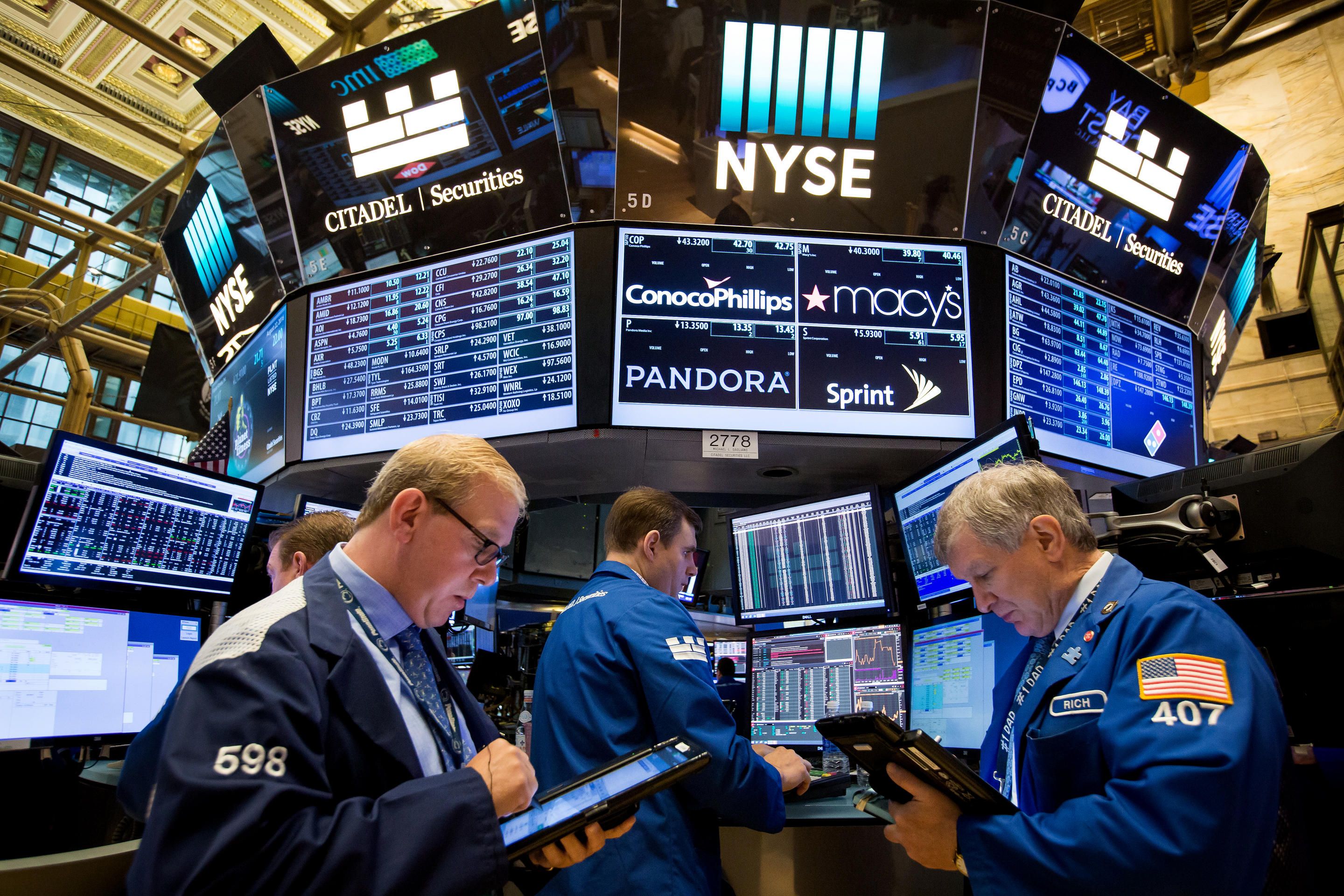Economy
US Stocks Open Higher

By Investors Hub
The major U.S. index futures are pointing to a higher opening on Monday, with stocks likely to move to the upside following the mixed performance seen last week.
The upward momentum on Wall Street comes as traders seem to be expressing optimism about upcoming trade talks between the U.S. and China.
Trading activity may be somewhat subdued, however, with a lack of major U.S. economic data likely to keep some traders on the sidelines.
Stocks moved mostly higher over the course of the trading session on Friday after recovering from an early move to the downside. The Dow added to the substantial gain posted in the previous session to reach its best closing level in nearly six months.
The major averages gave back some ground going into the close but remained in positive territory. The Dow climbed 110.59 points or 0.4 percent to 25,669.32, the Nasdaq inched up 9.81 points or 0.1 percent to 7,816.33 and the S&P 500 rose 9.44 points or 0.3 percent to 2,850.13.
For the week, the major averages turned in a mixed performance. While the Nasdaq dipped by 0.3 percent, the S&P 500 climbed by 0.6 percent and the Dow jumped by 1.4 percent.
Late-day buying interest was seen after a report from the Wall Street Journal said Chinese and U.S. negotiators are drawing up a road map for talks to try to end their trade impasse.
Citing officials in both nations, the Journal indicated the plan would culminate in planned meetings between President Donald Trump and Chinese leader Xi Jinping at multilateral summits in November.
The report comes following yesterday’s news that China accepted an invitation from the U.S. for a new round of trade talks to be held later this month.
China’s Ministry of Commerce said that a Chinese delegation led by Vice Commerce Minister Wang Shouwen will travel to the U.S. for trade talks to be held with U.S. Under Secretary of Treasury for International Affairs David Malpass.
The Journal said the U.S.-China trade talks in Washington would take place on August 21st and 22nd, just before the next round of tariffs targeting $16 billion worth of goods on both sides kick in on August 23rd.
In U.S. economic news, a report from the University of Michigan unexpectedly showed a notable deterioration in U.S. consumer sentiment in the month of August.
The preliminary report said the consumer sentiment index dropped to 95.3 in August after edging down to 97.9 in July. Economists had expected the index to inch up to 98.0.
Surveys of Consumers chief economist Richard Curtin said the decrease in consumer sentiment was concentrated among households in the bottom third of the income distribution amid less favorable perceptions of market prices.
“Overall, the data indicate that consumers have little tolerance for overshooting inflation targets, and to the benefit of the Fed, interest rates now play a more decisive role in purchase decisions,” Curtin said.
Meanwhile, a separate report from the Conference Board showed a bigger than expected increase by its index of leading U.S. economic indicators in the month of July.
The Conference Board said its leading economic index climbed by 0.6 percent in July following a 0.5 percent increase in June. Economists had expected the index to rise by 0.4 percent.
“The U.S. LEI increased in July, suggesting the US economy will continue expanding at a solid pace for the remainder of this year,” said Ataman Ozyildirim, Director of Business Cycles and Growth Research at the Conference Board.
After falling sharply in recent sessions, gold stocks showed a substantial rebound on the day. The NYSE Arca Gold Bugs Index surged up by 2.5 percent, bouncing off its lowest closing level since early 2016.
The rebound by gold stocks came as the price of the precious saw further upside in electronic trading after ending the regular session only slightly higher.
Steel stocks also saw significant strength amid optimism about the trade talks between the U.S. and China, with the NYSE Arca Steel Index advancing by 1.3 percent. The index climbed further off the eight-month closing low set on Wednesday.
Tobacco, computer hardware, and retail stocks also saw notable strength, while most of the other major sectors showed more modest moves to the upside.
Economy
Customs Street Chalks up 0.12% on Santa Claus Rally

By Dipo Olowookere
The Nigerian Exchange (NGX) Limited witnessed Santa Claus rally on Wednesday after it closed higher by 0.12 per cent.
Strong demand for Nigerian stocks lifted the All-Share Index (ASI) by 185.70 points during the pre-Christmas trading session to 153,539.83 points from 153,354.13 points.
In the same vein, the market capitalisation expanded at midweek by N118 billion to N97.890 trillion from the preceding day’s N97.772 trillion.
Investor sentiment on Customs Street remained bullish after closing with 36 appreciating equities and 22 depreciating equities, indicating a positive market breadth index.
Guinness Nigeria chalked up 9.98 per cent to trade at N318.60, Austin Laz improved by 9.97 per cent to N3.20, International Breweries expanded by 9.85 per cent to N14.50, Transcorp Hotels rose by 9.83 per cent to N170.90, and Aluminium Extrusion grew by 9.73 per cent to N16.35.
On the flip side, Legend Internet lost 9.26 per cent to close at N4.90, AXA Mansard shrank by 7.14 per cent to N13.00, Jaiz Bank declined by 5.45 per cent to N4.51, MTN Nigeria weakened by 5.21 per cent to N504.00, and NEM Insurance crashed by 4.74 per cent to N24.10.
Yesterday, a total of 1.8 billion shares valued at N30.1 billion exchanged hands in 19,372 deals versus the 677.4 billion shares worth N20.8 billion traded in 27,589 deals in the previous session, implying a slump in the number of deals by 29.78 per cent, and a surge in the trading volume and value by 165.72 per cent and 44.71 per cent apiece.
Abbey Mortgage Bank was the most active equity for the day after it sold 1.1 billion units worth N7.1 billion, Sterling Holdings traded 127.1 million units valued at N895.9 million, Custodian Investment exchanged 115.0 million units for N4.5 billion, First Holdco transacted 40.9 million units valued at N2.2 billion, and Access Holdings traded 38.2 million units worth N783.3 million.
Economy
Yuletide: Rite Foods Reiterates Commitment to Quality, Innovation

By Adedapo Adesanya
Nigerian food and beverage company, Rite Foods Limited, has extended warm Yuletide greetings to Nigerians as families and communities worldwide come together to celebrate the Christmas season and usher in a new year filled with hope and renewed possibilities.
In a statement, Rite Foods encouraged consumers to savour these special occasions with its wide range of quality brands, including the 13 variants of Bigi Carbonated Soft Drinks, premium Bigi Table Water, Sosa Fruit Drink in its refreshing flavours, the Fearless Energy Drink, and its tasty sausage rolls — all produced in a world-class facility with modern technology and global best practices.
Speaking on the season, the Managing Director of Rite Foods Limited, Mr Seleem Adegunwa, said the company remains deeply committed to enriching the lives of consumers beyond refreshment. According to him, the Yuletide period underscores the values of generosity, unity, and gratitude, which resonate strongly with the company’s philosophy.
“Christmas is a season that reminds us of the importance of giving, togetherness, and gratitude. At Rite Foods, we are thankful for the continued trust of Nigerians in our brands. This season strengthens our resolve to consistently deliver quality products that bring joy to everyday moments while contributing positively to society,” Mr Adegunwa stated.
He noted that the company’s steady progress in brand acceptance, operational excellence, and responsible business practices reflects a culture of continuous improvement, innovation, and responsiveness to consumer needs. These efforts, he said, have further strengthened Rite Foods’ position as a proudly Nigerian brand with growing relevance and impact across the country.
Mr Adegunwa reaffirmed that Rite Foods will continue to invest in research and development, efficient production processes, and initiatives that support communities, while maintaining quality standards across its product portfolio.
“As the year comes to a close, Rite Foods Limited wishes Nigerians a joyful Christmas celebration and a prosperous New Year filled with peace, progress, and shared success.”
Economy
Naira Appreciates to N1,443/$1 at Official FX Market

By Adedapo Adesanya
The Naira closed the pre-Christmas trading day positive after it gained N6.61 or 0.46 per cent against the US Dollar in the Nigerian Autonomous Foreign Exchange Market (NAFEM) on Wednesday, December 24, trading at N1,443.38/$1 compared with the previous day’s N1,449.99/$1.
Equally, the Naira appreciated against the Pound Sterling in the same market segment by N1.30 to close at N1,949.57/£1 versus Tuesday’s closing price of N1,956.03/£1 and gained N2.94 on the Euro to finish at N1,701.31/€1 compared with the preceding day’s N1,707.65/€1.
At the parallel market, the local currency maintained stability against the greenback yesterday at N1,485/$1 and also traded flat at the GTBank forex counter at N1,465/$1.
Further support came as the Central Bank of Nigeria (CBN) funded international payments with additional $150 million sales to banks and authorised dealers at the official window.
This helped eased pressure on the local currency, reflecting a steep increase in imports. Market participants saw a sequence of exchange rate swings amidst limited FX inflows.
Last week, the apex bank led the pack in terms of FX supply into the market as total inflows fell by about 50 per cent week on week from $1.46 billion in the previous week.
Foreign portfolio investors’ inflows ranked behind exporters and the CBN supply, but there was support from non-bank corporate Dollar volume.
As for the cryptocurrency market, it witnessed a slight recovery as tokens struggled to attract either risk-on enthusiasm or defensive flows.
The inertia follows a sharp reversal earlier in the quarter. A heavy selloff in October pulled Bitcoin and other coins down from record levels, leaving BTC roughly down by 30 per cent since that period and on track for its weakest quarterly performance since the second quarter of 2022. But on Wednesday, its value went up by 0.9 per cent to $87,727.35.
Further, Ripple (XRP) appreciated by 1.7 per cent to $1.87, Cardano (ADA) expanded by 1.2 per cent to $0.3602, Dogecoin (DOGE) grew by 1.1 per cent to $0.1282, Litecoin (LTC) also increased by 1.1 per cent to $76.57, Solana (SOL) soared by 1.0 per cent to $122.31, Binance Coin (BNB) rose by 0.6 per cent to $842.37, and Ethereum (ETH) added 0.3 per cent to finish at $2,938.83, while the US Dollar Tether (USDT) and the US Dollar Coin (USDC) remained unchanged at $1.00 each.
-

 Feature/OPED6 years ago
Feature/OPED6 years agoDavos was Different this year
-
Travel/Tourism9 years ago
Lagos Seals Western Lodge Hotel In Ikorodu
-

 Showbiz3 years ago
Showbiz3 years agoEstranged Lover Releases Videos of Empress Njamah Bathing
-

 Banking8 years ago
Banking8 years agoSort Codes of GTBank Branches in Nigeria
-

 Economy3 years ago
Economy3 years agoSubsidy Removal: CNG at N130 Per Litre Cheaper Than Petrol—IPMAN
-

 Banking3 years ago
Banking3 years agoFirst Bank Announces Planned Downtime
-

 Banking3 years ago
Banking3 years agoSort Codes of UBA Branches in Nigeria
-

 Sports3 years ago
Sports3 years agoHighest Paid Nigerian Footballer – How Much Do Nigerian Footballers Earn













